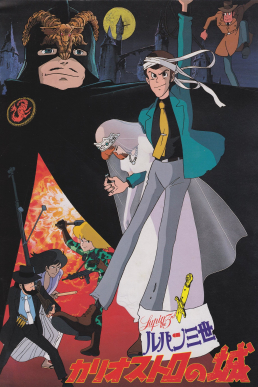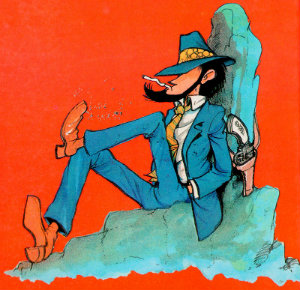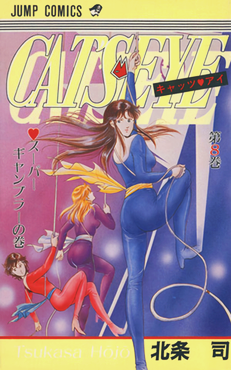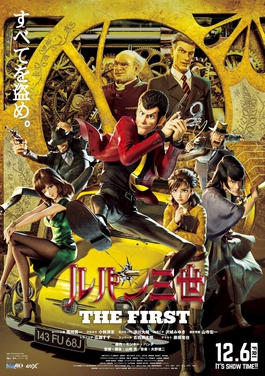
Lupin III: The Castle of Cagliostro is a 1979 Japanese animated action-adventure comedy film co-written and directed by Hayao Miyazaki, with animation produced by Tokyo Movie Shinsha. It is the second animated feature film featuring Monkey Punch's master thief Lupin III, from his manga series of the same name. The film was Miyazaki's feature-length directorial debut after having previously worked as an animator for Toei Animation and Telecom Animation Film and directing several television shows, including Lupin the Third Part I.
Lupin III, also written as Lupin the Third, Lupin the 3rd, or Lupin the IIIrd, is a Japanese media franchise created by Monkey Punch in 1967. The series follows the endeavors of master thief Lupin III, grandson of gentleman thief Arsène Lupin, joined by his criminal gang. The original Lupin III manga began in Weekly Manga Action on August 10, 1967. The series' success spawned a media franchise that includes numerous manga, seven animated television series, eleven theatrically released animated films, two live-action films, five OVA works, twenty-seven animated television specials, two musicals, and several video games.

Daisuke Jigen is a fictional character created by Monkey Punch for his manga series Lupin III, which debuted in Weekly Manga Action on August 10, 1967. Jigen is the marksman, aide-de-camp and best friend of Arsène Lupin III. Along with colleague Goemon Ishikawa XIII, he joins Lupin in pursuit of riches acquired typically by theft. Traveling across the globe, Jigen has garnered fame as a gunman with a wildly capable speed and accuracy.
Yuji Ohno is a Japanese jazz musician. Ohno is known for his musical scoring of Japanese anime television series, particularly Lupin III, and most famously the 1977 series Lupin III Part II and the feature film The Castle of Cagliostro.

Cat's Eye is a Japanese manga series written and illustrated by Tsukasa Hojo. It was serialized in Shueisha's shōnen manga magazine Weekly Shōnen Jump from 1981 to 1985, with its chapters collected into 18 tankōbon. The story follows the adventures of the three Kisugi sisters — Hitomi, Rui and Ai, who are formidable art thieves trying to collect all the works belonging to their missing father.

Lupin the 3rd: Treasure of the Sorcerer King is a stealth/action video game from Banpresto. It has an original story based on the manga and media franchise Lupin III. The gameplay relies heavily on stealth and the use of various disguises and is displayed from a third-person perspective.

Lupin III, referred to in some English adaptations as Arsène Lupin III, is a fictional character created by Kazuhiko Kato aka Monkey Punch as the protagonist for his manga series Lupin the Third, which debuted in Weekly Manga Action on August 10, 1967.

Lupin the 3rd Part III is a Japanese anime television series produced by Tokyo Movie Shinsha. Part of the Lupin III franchise, it is the third anime television adaptation of the Lupin III manga series created by Monkey Punch. The series aired on Yomiuri Telecasting Corporation between March 3, 1984 and November 6, 1985.

Lupin the 3rd Part II, also known as Shin Lupin III or simply as Lupin III for the American market, is a Japanese anime series based on the manga by Monkey Punch and is produced by Tokyo Movie Shinsha. The first season, which contains 26 episodes, aired between October 3, 1977 and April 3, 1978 on NTV. The opening theme is Theme from Lupin III '77 by Yuji Ohno, while the ending theme is the instrumental version of Love Theme, also by Yuji Ohno. In the United States, twenty-six episodes of English adaptation of the series aired on Adult Swim starting on January 14, 2003 at midnight ET with the exception of episode 3, which was skipped due to its Nazi themes. In Canada, the entire first season of the series aired on G4techTV's Anime Current from May 7 to June 11, 2007.

Lupin the Third: The Woman Called Fujiko Mine is a Japanese anime television series produced by TMS Entertainment. Part of the Lupin III franchise, it is the fourth anime television adaptation of the Lupin III manga series created by Monkey Punch. Directed by Sayo Yamamoto, it aired on Nippon TV from April to June 2012. It focuses on the franchise's heroine, Fujiko Mine, as she undergoes various missions and encounters the rest of the Lupin III cast for the first time. Unlike the franchise's previous three televised anime, The Woman Called Fujiko Mine is more sexually oriented in order to capture the "sensuality" present in the original manga, as well as darker and more serious. It is also the only installment in the franchise to be directed by a woman and the first in which Lupin III is not the protagonist.

Lupin the 3rd Part I is a Japanese anime television series produced by Tokyo Movie. Part of the Lupin III franchise, it is the first anime television adaptation of the Lupin III manga series created by Monkey Punch. The series was originally broadcast as simply Lupin III on Yomiuri TV between October 24, 1971 and March 26, 1972. Among English-speaking fans, this series was commonly known as the "Green Jacket" series in reference to Lupin's outfit, but more recently it is now known as "the first Green Jacket" series because of the outfit's return in Part 6.

Lupin the 3rd Part IV: The Italian Adventure, also known simply as Lupin the Third Part IV, is a Japanese anime television series animated by Telecom Animation Film. Part of the Lupin III franchise, it is the fifth anime television adaptation of the Lupin III manga series created by Monkey Punch. The series aired from August to November 2015 on Italia 1 in Italy, and from October 2015 to March 2016 on Nippon TV in Japan. It started airing in the United States on Adult Swim's Toonami programming block in June 2017.

TMS Entertainment Co., Ltd., formerly known as the Tokyo Movie Shinsha Co., Ltd., also known as Tokyo Movie or Kyokuichi Tokyo Movie, is a Japanese animation studio established on October 22, 1946.

Lupin the 3rd Part V: Misadventures in France, also known simply as Lupin the Third Part 5, is a Japanese anime television series produced at Telecom Animation Film, directed by Yūichirō Yano, and written by Ichirō Ōkouchi. Part of the Lupin III franchise, it is the sixth anime television adaptation of the Lupin III manga series created by Monkey Punch.

Lupin III: The First is a 2019 Japanese computer-animated heist comedy film based on the Lupin the Third franchise created by Monkey Punch, to whom the film is dedicated. Written and directed by Takashi Yamazaki, it was animated by Marza Animation Planet and TMS Entertainment, and is the first 3DCG installment in the franchise. The film stars Kanichi Kurita as Lupin III, Kiyoshi Kobayashi as gunman Daisuke Jigen, Daisuke Namikawa as samurai Goemon Ishikawa XIII, Miyuki Sawashiro as Fujiko Mine, and Kōichi Yamadera as Interpol detective Zenigata. The film's plot structure is loosely modelled after Hayao Miyazaki's classic Lupin III anime film Castle of Cagliostro (1979).

Rhythm Formula is the sixth studio album by J-pop duo Two-Mix, released by WEA Japan on November 25, 1999. It includes the singles "Truth ", "Body Makes Stream", and "Maximum Wave", as well as the song "Last Tears ". Rhythm Formula is the duo's first double album, with the second disc featuring variations of the duo's side projects and covers of Yellow Magic Orchestra's "Technopolis", Mariko Nagai's "Keep on 'Keeping On'", and Yuji Ohno's "Theme from Lupin the Third". "Truth " is a hidden track on disc 2, with vocalist Minami Takayama singing as Conan Edogawa.














